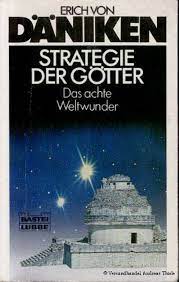Articles/Essays – Volume 16, No. 4
More Extraterrestrials | Erich van Daniken, Strategie der Götter, Das Achte Weltwunder
When i saw this book for the first time I ignored it as I have done with all of the other books by the popular nonfiction Swiss author and world traveler, Erich von Daniken. He is known as the leading proponent of the “Gods were astronauts” theory, and I could not make up my mind about him. Nevertheless, many Church members find some of his observations interesting and worthy of discussion.
My attention was first drawn to his recent book when an elderly member of my ward told me that von Daniken was writing a series about the golden plates for one of West Germany’s popular TV jour nals. In previous European books dealing with pre-Columbian archeology, he briefly mentioned the Book of Mormon, but only to deny its claim as a historical record. It was discussed mainly in connection with the common theory of the lost tribes.
Von Daniken’s books, which are widely read, mostly deal with archeological topics for which a scientific explanation remains uncertain and controversial. He is not fond of modern sciences which he claims have turned “dogmatic and intolerant” (p. 221). Since von Daniken searches rather indis criminately for any kind of unclassified artifact to promote his observations of extraterrestrial life, he believes in the “freedom of [his own] fantasy.” This is one rea son for his reputation as an outsider on the fringes of credibility. Therefore he is eager to find any source which can support his observations and theories.
I was curious to see what von Daniken had to say about the Book of Mormon. Strategy of the Gods deals explicitly but not exclusively with the Book of Mormon. The Book of Mormon connection is clearest on the dust jacket:
About . . . 2500 years ago a spaceship flew above our shocked ancestors. The commander of the extraterrestrials instructed a group of people in ship building, gave them a compass, and decoyed them by sea from the Jerusalem area to South America. When the temple construction was completed, the commander flew back to Babylon and brought back the Prophet Ezekiel to show him the new temple in South America . . .”
This scenario, though untenable to Mor mons, is not completely unfamiliar. The Nephites may have built some of the ruins in South America. In 1980, LDS missionaries posed such a question to Daniken (p. 50), and he thought of Chavin de Huantar in Peru, a temple that fits some but not all of the description of Ezekiel. This was a clue that also became a link, a suggestion.
This book is the first one I know of that positively supports the Book of Mor mon. The book’s first chapter retells the story of Moroni’s visit to Joseph Smith without mentioning the First Vision. The author doesn’t explain the role of the Prophet Joseph Smith but is convinced that he actually possessed the golden plates or “treasure” as he calls them. The testimonies of the eleven Book of Mormon wit nesses is not the only proof of the plates, he contends. The contents themselves constitute proof. This is alluring bait for the LDS reader. He treats Mormonism positively and respectfully. He also quotes some historical sources linked to the Book of Mormon, like the Popul Vuh or Atra Hasis mythologies.
Thereafter, however, the reader will be confused. Von Daniken does not intend to prove exactly which part of the Book of Mormon might be true. Rather than claiming total falsification of the translation, von Daniken is sure of “partial” falsification, by whom he does not say. He says, for example, that 1 and 2 Nephi and Ether are “adventurously exciting, informative, and without falsification, but it’s regrettable that some ‘plump’ prophesies about Jesus were added to continue biblical history” (pp. 49-50).
Some contemplations in Strategy of the Gods are surely based on von Daniken’s “freedom of fantasy.” For example, the Jaredites and Nephites had to build ships, he says, because spacecraft of this time weren’t advanced enough to give so many passengers a lift. In another case, the Nephites “diligently” practiced plural marriage (for the author a link to the nineteenth-century practice) to get enough offspring to build the temple modeled after Solomon’s (p. 47).
The book includes a second work, The Eighth Wonder of the World, which re ports an excavation site in Columbia, called Buritaca 200, which von Daniken was al lowed to visit. The whole book itself is a mixture of his travel experiences in South America and his own lively observations and comments. I enjoyed the author’s in volving narratives and his eloquently ex pressed fear of the limitations of modern science. The book is fully illustrated, mainly with the author’s own photographs.
Some feel this bestseller will help missionary work in Germany, but I fail to contemplate this prospect with equanimity. Some of our elders and missionaries don’t seem to be particular about their sources either. We want to prove the divinity of the Book of Mormon as we understand it, but von Daniken’s purpose is not the same. Instead he is looking for more extraterrestrials. The purposes are not, I think, compatible.
Strategic der Gotter, Das Achte Welt wunder by Erich von Daniken (Dusseldorf: Econ, 1982), 320 pp., 32 Deutsche Mark.


 Back to full Issue
Back to full Issue

